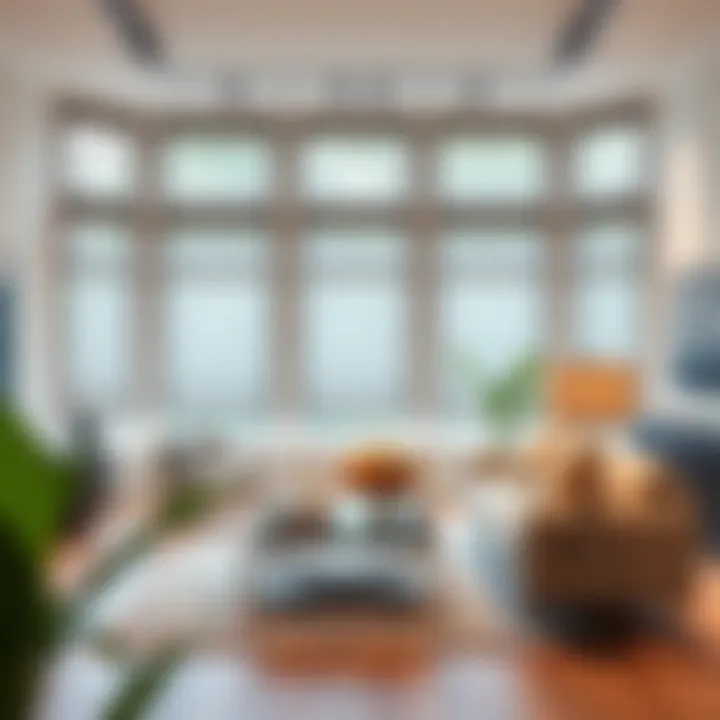Maximizing Comfort with Blackout Blinds in Tracks


Intro
In the world of interior design, the subtleties of light control can dramatically impact how a space feels and functions. Blackout blinds in tracks offer a unique blend of practicality and style, making them a sought-after choice among homeowners and design professionals alike. These window treatments allow you to manipulate not just the amount of light entering a room but also its overall ambiance.
As we navigate through the various aspects of blackout blinds installed within tracks, it’s essential to understand their benefits, types, installation techniques, and how they contribute to enhancing your space. More than mere fabric swatches, blackout blinds can transform an ordinary room into a serene retreat, offering solutions for energy efficiency and privacy concerns that are ever-relevant in today’s fast-paced lifestyle.
Furniture Design Insights
Implementing blackout blinds within a thoughtfully designed space requires more than just choosing a color palette. It’s about harmonizing style and utility, ensuring that each element complements the other.
Understanding Style Preferences
Designing with blackout blinds involves addressing personal style while considering the practicality they bring to the table. Many homeowners lean towards minimalistic designs that integrate smoothly with their existing decor. However, others may prefer bold patterns or colors that add a dash of flair.
For those who appreciate a cozy atmosphere, warm-toned blackout blinds can create a snug environment, perfect for a bedroom or home theater. For more modern settings, sleek, neutral blinds in tracks can maintain an air of sophistication while still delivering on functionality. Whatever the choice, the key is to select styles that not only meet aesthetic desires but also offer the desired light control.
Maximizing Space with Smart Layouts
When it comes to small spaces, choosing practical design elements is paramount. Blackout blinds in tracks can be an ideal solution for maximizing light control without bulky fixtures. They can be installed in a manner that allows them to slide effortlessly, freeing up precious wall and window space.
In addition, considering the layout of furniture is crucial. For instance, if the blinds are to be installed in a dining area or home office, positioning them away from the direct line of sight to the seating can create an inviting feel. This thoughtful approach optimizes both form and function, ensuring the room feels open and well-organized.
Maintenance and Care Tips
Ensuring that your blackout blinds remain functional and stylish over time involves a dedicated maintenance regimen. Not only does this prolong their life, but it also enhances the overall aesthetic of your space.
Cleaning Techniques for Different Materials
The cleaning methods you adopt can vary significantly based on the materials of your blinds. For fabric blinds, using a soft brush attachment on a vacuum can reduce dust buildup. In contrast, vinyl or wooden blinds may require a damp cloth for spot cleaning. Regular maintenance is important; otherwise, grime can build up and reduce their efficacy.
Preventative Measures Against Wear and Tear
Every so often, preventive measures can go a long way in preserving the material. Shades or blinds should avoid prolonged exposure to direct sunlight to prevent fading. Moreover, ensuring that they are installed correctly can minimize potential damage caused by wear and tear, as poorly fitted blinds tend to catch or snag.
"In the blend of style and practicality, blackout blinds in tracks offer a unique solution that transcends mere decoration."
For more insights, education, and recommendations related to design, feel free to browse through resources such as Britannica, Reddit, and relevant guides from educational institutions that discuss the functionalities of interior design materials.
Understanding Blackout Blinds
In the landscape of window treatments, blackout blinds have carved out a significant niche, particularly for those seeking control over light and privacy. Their efficacy goes beyond mere aesthetics, addressing practical needs in a variety of settings—from bedrooms to home theaters. Understanding what blackout blinds are and how they function is crucial for homeowners, DIY enthusiasts, and design professionals alike. This section unpacks the definition, features, and advantages that come with choosing blackout blinds, providing a comprehensive overview for those weighing their options.
Defining Blackout Blinds
Blackout blinds are window coverings designed to block out light completely. Unlike traditional curtains or shades, they are crafted with specific materials that obstruct sunlight, creating a darkened space when deployed. Often made from dense, light-absorbing fabrics or thermal backings, these blinds prevent any light intrusion, effectively transforming a bright room into a serene sanctuary. This capability makes blackout blinds particularly appealing for individuals who work night shifts, parents with young children, or anyone simply craving a darker environment for sleep or relaxation.
In many instances, blackout blinds are installed within tracks to ensure a snug fit, thus enhancing their light-blocking properties and providing a smooth operation. This setup not just adds to the effectiveness of blocking out light but also elevates the overall aesthetic and functionality of the surrounding space.
Key Features and Benefits
The allure of blackout blinds lies in a myriad of features and benefits that make them a top choice for many. Here are some key aspects to consider:
- Light Control: The primary feature of blackout blinds is their ability to block out light entirely. This quality is invaluable for anyone looking to create a darkened environment—be it for sleep, movie-watching, or simply to enhance comfort.
- Privacy: In addition to controlling light, blackout blinds also provide increased privacy, shielding the interior from prying eyes. This aspect is especially critical in urban settings or for rooms facing busy streets.
- Energy Efficiency: Blackout blinds offer thermal insulation, helping keep residences cooler in summer and warmer in winter. This energy-saving feature reduces reliance on heating and cooling systems, translating into lower energy bills.
- Noise Reduction: The thick materials used in blackout blinds can also help dampen outside noise, creating a more tranquil indoor atmosphere. Whether living in a bustling city or a quiet suburb, this reduction can significantly enhance the living experience.
- Variety of Styles: Available in numerous styles, colors, and materials, blackout blinds can seamlessly integrate with any interior design scheme. From modern to traditional, finding a fit for every taste is manageable.
"Blackout blinds not only block light, they create an oasis of calm and comfort, transforming any room into a retreat from the outside world."
In summary, understanding blackout blinds entails recognizing their functional design and multifaceted benefits. With their capacity to control light, privacy, and energy efficiency, these window coverings are a worthy investment for anyone looking to improve their living space.
The Role of Tracks in Blackout Blinds
Blackout blinds are more than just a decorative touch for windows; they serve a significant purpose that extends beyond aesthetics. Tracks play a crucial role in the function of these blinds, acting as the foundational element that supports them. Whether you want to block out light for optimal sleep or create a cozy environment in your living space, understanding the importance of tracks in blackout blinds can guide you to make informed choices. Knowing how they work also helps when it comes to selecting the right type for your home.
Functionality of Tracks


The functionality of tracks in blackout blinds cannot be overstated. They provide a seamless mechanism for raising and lowering the blinds with minimal effort. Tracks allow the blinds to glide smoothly, preventing any snagging or jamming, which can sometimes happen with less quality products. The design of the track ensures that the blinds sit snugly against the window frame, which is essential for maximizing light blockage.
Some tracks include features that enhance usability, such as:
- Dual Operation: Allowing for the installation of two different types of blinds, one for blackout and another for light filtering, giving users more control.
- Cordless Options: Providing an option for those seeking a cleaner look, especially in homes with children or pets.
- Easy Install: Many modern tracks come designed for easy installation, taking the hassle out of set-up for DIY enthusiasts.
Because of the durability and reliability of tracks, they can hold heavier blackout materials as well without compromising their effectiveness. It’s much like the difference between a strong hitch on a truck and a flimsy one; the latter just doesn’t do the job.
Types of Tracks Available
When it comes to tracks for blackout blinds, a variety of options can meet different needs and preferences. Choosing the right type can make all the difference in the overall effectiveness of your blinds. Here are some common types to consider:
- Aluminum Tracks: Known for their strength and longevity. They are resistant to warping and bending, making them a popular choice.
- Plastic Tracks: Generally more affordable; these tracks work well in less demanding environments. They might not last as long as aluminum but can still serve adequately in most settings.
- Wooden Tracks: Providing a natural aesthetic, these tracks can blend seamlessly with traditional interiors. They do require more maintenance, but their visual appeal is often worth the effort.
- Curtain Tracks: While primarily used for curtains, some versions can effectively accommodate blackout blinds, giving you flexibility in design.
Each type has its pros and cons, and it’s crucial to assess them in relation to your specific situation.
"Success in selecting blackout blinds isn’t just about the blinds themselves, but how well the tracks work with them."
Understanding the role tracks play is essential. They are the unsung heroes in the world of blackout blinds, often overlooked yet pivotal in ensuring they perform as promised. Using the right track can ultimately augment the benefits of blackout blinds, from energy efficiency to privacy, ensuring that your space feels just right.
Types of Blackout Blinds
In the realm of window treatments, the type of blackout blinds chosen can make a significant difference in aesthetics, functionality, and overall satisfaction. Whether you are a designer crafting a stylish room or a homeowner seeking quiet sanctuary, understanding the variety of blackout blinds available will help in making an informed decision that benefits your specific needs. Each type offers unique features and considerations, influencing both the visual appeal and practical applications in different settings.
Roller Blinds
Roller blinds are often regarded as the go-to choice for simplistic elegance. Their design is straightforward yet effective, functioning like a shield against unwanted light. They come in different materials, ensuring that you can select the perfect fabric for insulation or decoration. The efficiency of roller blinds in blocking light is largely attributed to their flat surface and tight fit against the window, providing a seamless barrier that can transform any brightly-lit space into a cozy haven.
Furthermore, roller blinds can be customized in terms of color and pattern, making them suitable for a diverse range of interior designs. If you prefer a contemporary look, sleek gray or bold patterns can fit the bill. Also, one should consider their ease of operation—many modern roller blinds come with smooth mechanisms that allow for effortless rolling.
Venetian Blinds
Then there are Venetian blinds, which allow for versatile control of light and privacy. Their slatted structure means you can easily adjust the angle of the slats to let in just the right amount of light while keeping nosy neighbors at bay. Often made with either plastic, metal, or wood, these materials contribute to their durability while also influencing their aesthetic appeal.
For those looking to blend functionality with style, Venetian blinds serve as a classic solution. Adjusting them can result in varying atmospheres, from bright and airy to warm and snug. Their distinctive design also offers a touch of sophistication that suits traditional as well as modern settings, giving versatility unmatched by other types.
"The appeal of Venetian blinds lies in their adaptability; they fit into almost any design theme, making them a smart choice for any room."
Pleated Blinds
Pleated blinds represent a clever fusion of form and function. With their unique folding design, they are not only visually striking but also incredibly effective at insulating windows. Pleated blinds can be drawn up or down, which provides added flexibility to adjust light and privacy levels. Their pleats create a honeycomb structure when closed, trapping air and thus enhancing energy efficiency.
Various fabric choices further enable homeowners to achieve the desired ambiance. From sheer options that gently filter light to heavier fabrics that blackout full sunlight, the selection is vast. Keeping in mind that pleated blinds may require careful, routine cleaning to maintain their crisp look is vital, but their advantages certainly outweigh this consideration.
Panel Blinds
Lastly, panel blinds stand out due to their striking visual profile and practicality. Ideal for larger windows or sliding doors, these blinds consist of broad fabric panels that slide along a track system. Panel blinds allow for a more dramatic presentation in a room while still serving the purpose of light control and insulation. The modular design offers endless design possibilities, pairing well with both minimalistic and bold décor styles.
Their adaptability is a key advantage, enabling homeowners to seamlessly transition between privacy and openness. With the option for different materials such as sheer or blackout fabric, panel blinds can enhance the style of a room while fulfilling specific functional requirements.
A thorough understanding of different types of blackout blinds will allow individuals to make choices that best suit their lifestyle and aesthetic preferences, paving the way for a more harmonious living space.
Installation of Blackout Blinds in Tracks
Installing blackout blinds in tracks is a pivotal step that enhances the overall functionality and aesthetic of any living space. The significance of this process cannot be overstated; it ensures that the blinds operate smoothly while providing maximum light control, privacy, and energy efficiency. Understanding the nuances of this installation is crucial for homeowners, DIY enthusiasts, and interior designers alike.
Preparation Steps
Before diving headfirst into the actual installation, proper preparation is essential. This not only sets the stage for a successful outcome but also saves time and frustration in the long run. Here are some key preparation steps:
- Gather Necessary Tools: Ensure you have the right tools, including a measuring tape, level, drill, and screwdrivers. Having everything ready beforehand helps streamline the process.
- Read Instruction Manuals: Each brand of blackout blinds may have specific guidelines; familiarize yourself with these instructions. Don’t skip this step; it could spare you from potential mishaps.
- Choose the Right Location: Identify which windows will be fitted with blackout blinds. Consider room function when making your decision. A bedroom might benefit from a thicker blind, whereas a living room could use a more stylish option.
This preparatory work will pave the way for a smoother installation process, allowing for a more stress-free experience.


Measuring for Perfect Fit
One of the most critical aspects of installing blackout blinds is accurate measuring. An ill-fitted blind can lead to gaps, reducing efficiency and aesthetic appeal. Follow these steps to ensure a perfect fit:
- Measure the Window Width: Use a measuring tape to determine the width of the window. Measure from one edge of the window frame to the other, ensuring to take it in three different places – at the top, middle, and bottom. Use the widest measurement.
- Measure the Height: For height, again measure in three spots – left side, middle, and right side – and use the tallest measurement. This way, you ensure coverage from top to bottom.
- Consider Mounting Type: Decide if you're opting for an inside mount (fitting within the frame) or an outside mount (covering the entire frame). This choice will affect your measurements.
Following these methods ensures precision, allowing the blinds to blend seamlessly into your decor.
Mounting the Tracks
Once you have your measurements, it’s time to get your hands dirty with track mounting. This step involves installing the hardware that will support your blinds, and it’s crucial for their functionality.
- Mark the Installation Spots: Using a pencil, mark where the tracks will go based on your earlier measurements. Make sure they are level. A small miscalculation here could lead to disastrous results, so heed this step.
- Drill Pilot Holes: Depending on the material of your window frame or wall, you might need to drill pilot holes. Always confirm the appropriate size for the screws you will be using. Doing this makes for easier installation and less likelihood of splitting the wood or damaging drywall.
- Install the Tracks: Align the tracks with your marked spots and screw them into place. Use a level to double-check alignment. This measure will avoid any lopsided blinds later on.
Proper mounting is essential as it assures the stability of the blinds over time, ensuring smooth operation and durability.
Attaching the Blinds
With the tracks securely installed, it’s time to attach the blinds. This step might feel like the final touch, but it truly brings everything together.
- Hang the Blinds on the Tracks: Lift your blinds and carefully set them into the mounted tracks. Some blinds might require additional clips or hooks, so consult the manual for specific instructions.
- Test Operation: Before calling it a day, test your newly installed blinds. Ensure they slide smoothly up and down along the tracks. If they snag, reconsider the mounting or alignment.
- Make Adjustments: If the blinds aren't operating correctly, make necessary adjustments to the positioning of the tracks or the blinds themselves. Make sure everything lines up just right.
This final step is where your hard work pays off, transforming the functionality of your space while improving energy efficiency and aesthetics.
"The success of your blackout blinds installation lies in the details; meticulous preparation will always lead to a better fit and finish."
Enhancing Aesthetics with Blackout Blinds
When it comes to interior design, every aspect of a space contributes to the overall ambience. Blackout blinds, often perceived solely for their functional qualities, are actually a vital tool for enhancing aesthetics in any room. They serve not only to block out light but also to complement the decor while adding an element of sophistication and style.
Incorporating blackout blinds into your home décor is about strategically blending functionality with visual appeal. The right combination can transform a drab room into a visually engaging sanctuary. Their versatility gives homeowners and designers alike the freedom to choose styles that align with each room's character. For instance, placing sleek, modern roller blinds in a minimalist space can create clean lines, while heavy fabric pleated blinds can add warmth to a cozy setting.
Color and Fabric Selection
The choice of color and fabric for your blackout blinds plays a significant role in setting the mood of a room. It’s essential to consider what's going on in the surrounding space. Lighter colors like soft beige or pastel tones can brighten up a smaller room, making it feel more open. Meanwhile, deeper shades like navy blue or charcoal can evoke a rich sense of comfort and luxury, perfect for bedrooms or media rooms.
Fabric choice also matters greatly. Thicker materials might offer better insulation while contributing to the overall design. If you're dealing with a more traditional room aesthetic, perhaps look at fabrics with patterns, which can add depth and interest. But for a contemporary space, a smooth, crisp fabric could work wonders.
"Fabric is a silent messenger, speaking volumes about style and personal taste."
When selecting the color and fabric, consider how the blinds will interplay with other elements of the room. If the walls are a bold color, go for a neutral shade in the blinds for balance. Conversely, if the palette is muted, a pop of color in your blinds could become the focal point, captivating attention effortlessly.
Coordinating with Interior Design
Coordinating blackout blinds with the broader interior design theme is crucial to achieving a cohesive look. They shouldn't feel like an afterthought but rather an integral part of the room's narrative. Whether you prefer a rustic, modern, or classic theme, there's a way to match these blinds to enhance your overall design vision.
For a modern space, consider blackout blinds with simple, geometric patterns or solid colors. They can blend seamlessly with minimalist furniture and large windows often found in contemporary homes.
On the other hand, in a vintage-inspired room, you might select blinds that feature intricate patterns or textures reminiscent of the period. This touch not only elevates the aesthetic but also pays homage to traditional design elements.
One must also keep in mind the type of window treatments that best complement your existing furnishings. Layering blackout blinds with sheer curtains can create a stunning visual contrast while providing flexibility in light control. This method allows for easy transitions between a well-lit environment during the day and complete privacy at night.
In essence, blackout blinds can serve as both a practical solution and a stylish addition to your home. They transform windows into statements, enhancing both the functionality and appearance of the space while offering protection from unwarranted light. Whether you're a designer looking to create a harmonious space or a homeowner wishing to personalize your environment, considering the aesthetics of blackout blinds is key.
Energy Efficiency and Cost-Effectiveness
Understanding the energy efficiency and cost-effectiveness of blackout blinds installed in tracks is essential for homeowners and designers alike. As energy costs continue to rise, the demand for solutions that not only reduce expenses but also enhance comfort grows. Blackout blinds provide one of several reliable strategies to achieve that balance. Their pivotal role in controlling indoor climate cannot be overstated, especially in areas with extreme weather patterns.
Insulation Benefits
Blackout blinds serve as more than just a visual barrier; they provide notable insulation properties that can help to maintain your home’s temperature. When properly installed, these blinds act to trap air, creating a cushion between the window and the inside of your home. This reduces the heat gain during summer and heat loss in winter.
- Thermal Regulation: They prevent excessive heat from entering in warm months and stop the cold drafts in the chilling season, making a significant difference in comfort levels.
- Energy Conservation: By minimizing the need for heating and cooling, blackout blinds contribute to energy savings. Less reliance on HVAC systems means lower utility bills.
- Material Matters: The effectiveness of insulation can depend on the material. High-quality fabric options, such as those with thermally backed layers, can enhance their insulating properties.


"Properly used blackout blinds can lead to noticeable energy savings. Over time, this contributes to a significant impact on household energy consumption."
Long-term Savings
Investing in blackout blinds goes beyond the initial cost; it's about long-term savings. The initial outlay can seem significant, but the benefits stack up over time. Here are some key aspects to consider:
- Reduced Utility Bills: With improved insulation and energy efficiency, you can expect a drop in your heating and cooling expenses. This can lead to recovering your investment within a few seasons.
- Durability and Longevity: Quality blackout blinds are typically built to last, often outliving cheaper alternatives. By avoiding recurrent replacements, you not only save money but also lessen your environmental impact.
- Increased Property Value: Homes equipped with energy-efficient features are often viewed as more desirable in the market. Having blackout blinds adds to the energy efficiency credentials of a property, positively influencing its resale value.
Maintenance and Cleaning of Blackout Blinds
Maintaining and cleaning blackout blinds installed in tracks is not just about aesthetics; it’s crucial for ensuring their longevity and effectiveness. Dust and grime can accumulate over time, affecting the ability of these blinds to block out light, insulate spaces, and even enhance the overall decor of your home. Regular maintenance is essential in preserving the functionality and appearance of your blinds, making this section pivotal for homeowners, designers, and anyone invested in home decor.
Routine Cleaning Tips
To keep your blackout blinds looking their best, some routine cleaning practices can be quite helpful. Here’s a quick guide to help you stay on top of things:
- Dust Regularly: Utilize a soft microfiber cloth or a vacuum with a brush attachment to dust your blinds. Aim for once a week to prevent dust build-up, which can affect airflow and the effectiveness of the blinds.
- Spot Clean: For minor spills or stains, use warm water and a gentle detergent. Apply the solution with a soft sponge or cloth and dab—don’t rub—to avoid damaging the fabric.
- Rotate Blinds: If you have versatile types such as roller or pleated blinds, regularly changing their position helps prevent uneven sun exposure and keeps color fading in check.
- Deep Clean: Depending on your environment, a more in-depth clean every couple of months may be warranted. Remove the blinds and soak them in mild soapy water before rinsing them off thoroughly. Allow them to air dry completely before reinstallation.
Addressing Stains and Damage
Accidents happen, and over time, stains can appear on your blackout blinds, whether from spills, pet activities, or even just regular living. Here’s how to handle that with minimal fuss:
- Identify the Stain: Understanding what caused the stain will help in choosing the right cleaning method. For dark marks, use a damp cloth with a little vinegar, while grease stains may require a higher concentration of dish soap during cleaning.
- Immediate Action: When a stain occurs, act fast! The longer a stain sits, the harder it can be to remove. Gently blot the area with a cloth, avoiding vigorous rubbing that could cause more damage.
- Fabric Repair: If your blinds have suffered snags or tears, it may be possible to sew it back together depending on the material. For larger damages, consider using fabric glue or replacement parts, which many manufacturers offer.
- Consult the Professionals: In some cases, seeking professional cleaning services might be beneficial, especially when dealing with expensive or delicate fabrics. They have specialized products and tools that can breathe new life into worn-out blinds.
Keeping your blackout blinds in peak condition allows them to function as effectively as intended—blocking out light, maintaining privacy, and adding a touch of style to your space. Routine care should not be overlooked as it ensures your investment remains sound and serves its purpose for years to come.
Common Challenges and Solutions
Blackout blinds offer remarkable advantages, but their installation and usage can present a few hurdles. Understanding these common challenges is pivotal for homeowners and professionals alike. By addressing specific issues and proposing practical solutions, one can ensure that the benefits of blackout blinds are fully realized.
Potential Installation Issues
When it comes to installing blackout blinds in tracks, beginners may run into problems that can turn a seemingly straightforward task into an uphill battle. One of the primary hurdles is misalignment of the track, which can lead to uneven or malfunctioning blinds. To avoid this, precise measurements become crucial.
- Measure Twice, Cut Once: Before any installation begins, it's wise to double-check the measurements of both the window and the track. This straightforward suggestion might sound cliché, but it holds water in installation scenarios.
- Hardware Quality: Using inferior mounting brackets can lead to sagging or an outright failure of the system. Invest in durable, appropriate hardware that is compatible with the weight of the chosen blackout blinds.
Beyond these points, dealing with differing wall types — such as drywall versus concrete — also requires attention. The strategy differs; while drywall anchors work for lighter materials, concrete demands heavy-duty anchors. Thus it’s essential to use appropriate methods tailored to the installation’s backdrop.
Adjusting for Light Gaps
Light gaps are those pesky slivers of daylight that can peek through when blinds are improperly fitted or chosen. These little gaps can defeat the purpose of blackout blinds in the first place. Here are some options to remedy this issue:
- Choose the Right Size: Getting blinds that are wider and longer than the window frame will provide more coverage, which decreases light gaps significantly. For vertical or horizontal blinds, ensure they fully overlap the window edges.
- Add Extensions: If fitting blinds correctly still leaves light gaps, consider using side channels. These are narrow strips installed along the edges of the window to block light effectively. This method proves especially useful in eliminating gaps along the sides of the blinds.
- Consider the Fabric: Some blackout fabrics are denser than others. If light penetration is a significant issue, opt for a thicker fabric to improve the light-blocking ability of your blinds.
"Investing in quality and attention to detail during installation can ultimately save hours of frustration later on. Understand your needs and carefully choose the materials that align with them."
In summary, while challenges may arise during the installation and adjustment of blackout blinds, knowing what to watch out for can smooth the process. The strategies discussed above equip individuals — whether homeowners or designers — with the knowledge to navigate potential pitfalls effectively.
Final Considerations
As you wrap your head around the world of blackout blinds in tracks, it becomes clear that thoughtful deliberation can make all the difference. This section aims to highlight the essential points regarding your choice of blackout blinds, emphasizing their role not just as practical solutions but as vital components of your space. Whether you're a designer looking to create a specific ambiance or a homeowner aiming to boost comfort, understanding your needs and making well-informed choices is paramount.
Assessing Your Needs
Before you dive headfirst into selecting blackout blinds, take a moment to evaluate your personal requirements. Consider factors such as:
- Light Control: Do you need total darkness for a bedroom or just a reduction of glare in a work area?
- Noise Reduction: Some blinds can help in muffling outside sounds, which is significant after a long day.
- Energy Efficiency: Are you looking to keep heating or cooling costs down? Right blinds can improve insulation.
- Aesthetic Appeal: What style fits your home decor? The look of the blinds can influence the overall atmosphere of a room.
By sussing out these elements, you can ensure that yourfinal choice aligns perfectly with what you genuinely need, avoiding the one-size-fits-all trap.
Making Informed Choices
After you've pinpointed your requirements, it's time to transition those insights into concrete actions. Making informed choices involves several considerations:
- Material Selection: The fabric can make or break the effectiveness of blackout blinds; some materials are better suited for insulation, while others favor aesthetics.
- Track Compatibility: Not all blinds fit all track systems. Ensure the blinds you choose are designed for the type of tracks you have in place.
- Budget Constraints: Understand the cost implications of your choices. Sometimes spending a bit more upfront can lead to better durability and efficiency in the long run.
- Installation Complexity: Will you need professional help or is it feasible as a DIY project? Assess your skills and comfort level with installation chores.
Making informed choices sets the stage for a more satisfying and efficient product experience.
By merging personal needs with educated decision-making, you're setting yourself up not just for short-term satisfaction but also long-term enjoyment and efficacy from your blackout blinds in tracks.















